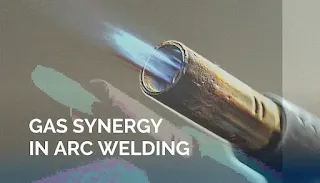Enhancing Welding Quality and Efficiency with Gas Synergy
Welding stands as a vital process within the realms of both manufacturing and construction industries, enabling the amalgamation of diverse materials to craft structures of resilience and longevity.
As the quest for refining the caliber of welded joints endures, the evolution of welding methods persists. One significant stride in this trajectory is the integration of gas synergy in arc welding procedures.
This article unveils the essence of gas synergy in arc welding, its manifold merits, and the prevalent roster of shielding gases that find application in this arena.
Gas Synergy in Arc Welding: Concept and Advantages
Gas synergy within the purview of arc welding delineates the deployment of supplementary shielding gases during the welding continuum, fostering an elevation in the standard of welded joints.
The cardinal intent underpinning gas synergy resides in the preservation of the thermal zone, molten metal, and the welded juncture from contamination ensuing from exposure to the atmospheric milieu.
The orchestration of an ambiance untainted by oxygen and sundry other elements in the vicinity of the welding locus serves as the fulcrum upon which gas synergy pivots, forestalling the genesis of voids, fractures, and sundry impurities that might imperil the robustness of the welded joint.
Paramount Merits of Gas Synergy in Arc Welding
1. Elevated Welding Prowess
The adjunct shielding gases contribute substantively to the genesis of weld joints characterized by immaculateness, bereft of maladies like voids and fractures. The upshot encapsulates structures endowed with enhanced robustness and tenacity.
2. Mitigated Deformity
The employment of shielding gases accords dominion over the velocity of thermal dissipation in the weld juncture, curtailing the specter of deformities or distortions within the material under manipulation.
3. Augmented Process Efficiency
Despite ushering in incremental expenditures, the integration of gas synergy in welding precipitates a diminution in the requisites for post-weld cleansing and a palliation of the demand for weld repetition consequent to imperfections.
4. Amplified Material Pliancy
The infusion of supplementary shielding gases confers welders with the liberty to navigate through an assemblage of materials, thereby attenuating the jeopardy of incongruities between the electrode and the foundational substrate.
Ubiquitous Strains of Shielding Gases
1. Argon
The mantle of argon, as a shielding gas, is routinely assumed in the theater of arc welding, lauded for its inertia and aversion to reactivity. It finds its niche in the welding of non-ferrous materials and stainless steel.
2. Helium
Helium predominantly garners employment in the welding of non-ferrous metals like aluminum. It imparts an augmentation in arc penetration and a concomitant amplification in the cadence of welding.
3. Fusion of Argon and Helium Gases
This alchemical admixture amalgamates the virtues of both argon and helium, frequently harnessed to fine-tune the caliber of weld joints spanning an array of material archetypes.
Coda:
The inception of gas synergy into the tapestry of arc welding delineates a watershed, heralding a trajectory that celebrates the augmentation of quality, efficiency, and adaptability within the precincts of welding procedures. Via the invocation of supplementary shielding gases, welders orchestrate the birth of weld joints that evoke superlative quality, buttressed by their immunity to maladies.
The scrupulous selection of an apropos shielding gas and a perspicacious grasp of its assimilation into the welding choreography constitute the sine qua non for the realization of outcomes that stand as apogees of excellence. In a dynamic cosmos marked by ceaseless evolution, gas synergy assumes its role as the cornerstone underpinning welding practices par excellence.
(gasinergy.com)

